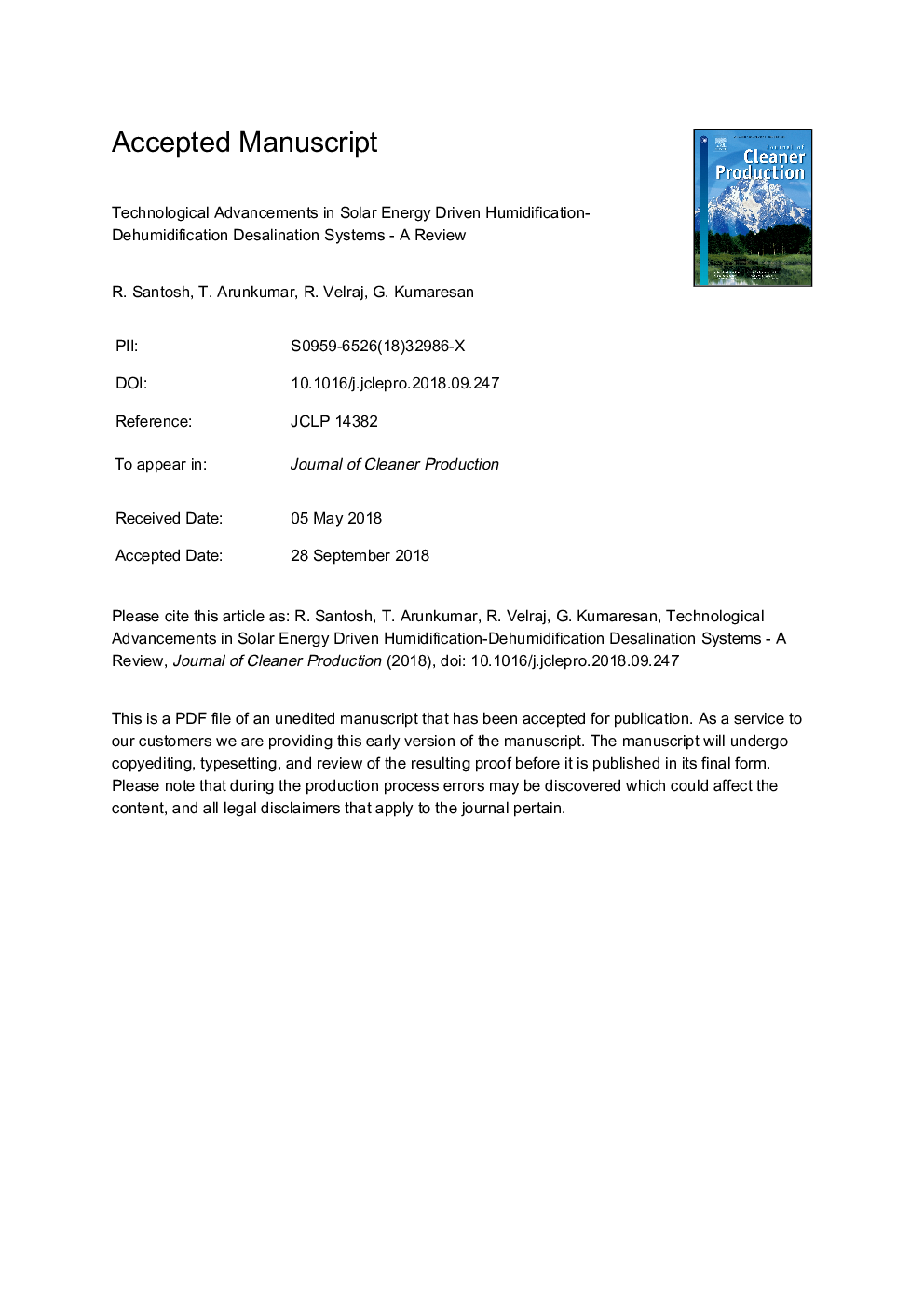| کد مقاله | کد نشریه | سال انتشار | مقاله انگلیسی | نسخه تمام متن |
|---|---|---|---|---|
| 11262899 | 1803333 | 2019 | 61 صفحه PDF | دانلود رایگان |
عنوان انگلیسی مقاله ISI
Technological advancements in solar energy driven humidification-dehumidification desalination systems - A review
ترجمه فارسی عنوان
پیشرفت های تکنولوژیکی در سیستم های آب شیرین کن رطوبت خنک سازی - خنک سازی سیستم خورشیدی - بررسی
دانلود مقاله + سفارش ترجمه
دانلود مقاله ISI انگلیسی
رایگان برای ایرانیان
کلمات کلیدی
رطوبت، رطوبت، فن آوری های انرژی خورشیدی، نمک زدایی، اب،
ترجمه چکیده
کمبود آب منجر به نیاز فوری برای توسعه یک تکنولوژی آب شیرین سازی ارزان و کارآمد برای تولید آب شیرین، به ویژه در کشورهای در حال توسعه است. به غیر از سایر فنآوریهای نوشابه سازی مؤثر، روند نشت آب رطوبت-رطوبت در دهه گذشته به دلیل مزایای متنوع آن در ساخت، نگهداری و بهره برداری سیستم، پذیرفته شده است. در این مقاله، یک بررسی جامع از پیشرفت های مختلف انجام شده به صورت تجربی برای بهبود عملکرد سیستم خلع سدیم رطوبت خورشیدی خورشیدی ارائه شده است. عوامل اصلی کمک به عملکرد سیستم افزایش یافته از قبیل جریان جریان جرم مایع انتقال حرارت، مکانیزم اجباری مجاور، تکنیک چند گذر، مکانیزم گردش خون، استفاده از مایع انتقال حرارت نانو و مواد تغییر فاز مورد بحث قرار گرفته است. علاوه بر این، اثر شدت خورشید، دمای محیط، سرعت باد، گرمایش و خنک شدن مرحله بر روی بهره وری آب شیرین نیز گزارش شده است. مشخص شد که ساخت و نگهداری آسان جمع کننده صفحات مسطح و شاخص عملکرد بالاتر جمع کننده لوله تخلیه آنها را به عنوان فن آوری های غالب برای گرم کردن آب انتقال حرارت حرارتی هوا در سیستم خلع سیتی رطوبت خورشیدی خورشید به ترتیب. علاوه بر این مشخص شده است که پتانسیل زیادی برای بهبود عملکرد آب شیرین از طریق سیستم های ترکیبی وجود دارد که شامل استفاده از انرژی زمین گرمایی یا انرژی زیست توده، ادغام عناصر خورشیدی با سیستم آب شیرین کننده رطوبت-رطوبت، اتصال خورشیدی، جمع آوری خورشید لنز فرلن و به ترتیب با کلکتور جمع کننده تخت و سیستم جمع آوری لوله تخلیه شده است. محدوده ای برای بهبود بیشتر در پارامترهای سیستم و پارامتر فرد مورد بحث قرار گرفته است.
موضوعات مرتبط
مهندسی و علوم پایه
مهندسی انرژی
انرژی های تجدید پذیر، توسعه پایدار و محیط زیست
چکیده انگلیسی
Water scarcity has resulted in a pressing need to develop an inexpensive and efficient desalination technology for fresh water production, especially in developing countries. Apart from other effective desalination technologies, humidification-dehumidification desalination process is predominantly adopted in the past decade to meet water deficiency due to its varied advantages in system construction, maintenance and operation. In this paper, a comprehensive review of the various advancements carried out experimentally for improving the performance of the solar humidification-dehumidification desalination system has been presented. The major factors contributing for enhanced system performance such as mass flow rate of heat transfer fluid, forced convection mechanism, multi-pass technique, recirculation mechanism, use of nano heat transfer fluid and phase change material are discussed. Further, the effect of solar intensity, ambient temperature, wind velocity, stage-wise heating and cooling on freshwater productivity is also reported. It was found that easy construction and maintenance of flat plate collector and higher performance index of evacuated tube collector make them as the predominant technologies adopted for heating the water and air heat transfer fluid's in solar humidification-dehumidification desalination system respectively. Further, it is identified that there exists a large potential for improving the fresh water yield through hybrid systems which involve use of geothermal or biomass energy, integration of solar stills with humidification-dehumidification desalination system, coupling of solar still, Fresnel lens solar collector and parabolic trough collector respectively with the flat plate collector and evacuated tube collector systems. The scope for further improvement in individual system and process parameters have been discussed.
ناشر
Database: Elsevier - ScienceDirect (ساینس دایرکت)
Journal: Journal of Cleaner Production - Volume 207, 10 January 2019, Pages 826-845
Journal: Journal of Cleaner Production - Volume 207, 10 January 2019, Pages 826-845
نویسندگان
R. Santosh, T. Arunkumar, R. Velraj, G. Kumaresan,
